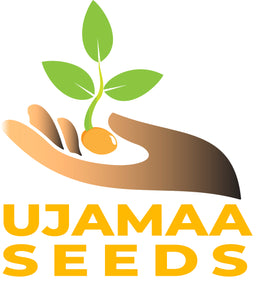Kawanda Sorghum
Sorghum bicolor subsp. bicolor
Seeds per packet ~ 70.
Germination: 96% (Aug 2024) Packed for 2025
Origins and History
Kawanda Sorghum is an heirloom variety with roots in East Africa, particularly associated with agricultural research and farmer field trials in Uganda. The name derives from Kawanda, a major agricultural research station that has long contributed to developing and preserving traditional sorghum lines. This variety reflects the resilience of African foodways, as sorghum has been cultivated for thousands of years as a staple grain across the continent, valued for its adaptability to hot, dry climates and its cultural role in food, drink, and ritual.
Appearance and Characteristics
Kawanda Sorghum produces tall, sturdy stalks ranging from 6 to 10 feet in height. The plants are topped with large, loose panicles bearing dense clusters of small round seeds, typically ranging in color from pale cream to reddish-brown, depending on the strain. Known for its drought tolerance and ability to grow in marginal soils, this variety maintains strong stems that also provide fodder for livestock, making it a dual-purpose crop.
Culinary Uses
The grain of Kawanda Sorghum is versatile in the kitchen. It can be ground into flour for flatbreads, porridges, or traditional fermented foods. The whole grains may be steamed, boiled, or popped like popcorn. In East Africa, it is often used in brewing local beverages, contributing both flavor and nutrition. Gluten-free and highly nutritious, sorghum is increasingly recognized as a healthy alternative grain worldwide.
Growing Tips
Kawanda Sorghum thrives in warm climates and is best suited for USDA Zones 7–11. It prefers full sun and well-drained soil, tolerating sandy or loamy ground. Sow seeds directly into the soil once temperatures are consistently above 65°F. Plant 1 inch deep, spacing seeds 4–6 inches apart in rows 24–36 inches apart. Thin seedlings as needed to prevent overcrowding. This sorghum variety is highly drought tolerant but benefits from moderate watering during establishment. It can also serve as a windbreak or companion crop due to its tall, strong stalks.
Harvesting Guidance
Sorghum is ready for harvest about 90–120 days after planting, depending on growing conditions. Grains are mature when the panicles turn dry and hard, and seeds resist denting when pressed. Harvest by cutting the seed heads and drying them thoroughly before threshing to remove the grain. For fodder use, stalks can be cut earlier while still green and succulent. Proper post-harvest drying ensures long-term storage and preserves seed quality for future planting.
This special dual-use sorghum is one of the sweetest-stalked sorghum varieties in the world. Officially known as 'L. 26 Kawanda', it tested in the top 5 overall for sucrose content in a USDA trial of 1,211 sorghums in the government collection (at 12.3% sucrose — most fall into the 2.75 to 5.5% range). The grains are beige-colored, mild-flavored, and easily hand-threshed. Plants are tall, productive, and resilient, but they do usually require a long season. These seeds were produced by our friend and colleague Amirah Mitchell, founder of Sistah Seeds, in Philadelphia — and we wouldn't recommend trying this variety much farther north than the Mid-Atlantic. But African sorghums like this can be unpredictable, seeming to be more dependent on rain patterns for determining flowering date than any other factor.
Many sorghums are listed in the government database as day-length sensitive, which usually means they won't begin to flower until too late in the season to produce seed in our region, but based on our experiences it's clear that many of these will produce seed early if there's a prolonged dry-spell in August — we presume this is because these sorghums have been adapted to the strict wet-season/dry-season dichotomy of their place of origin. So it's certainly worth trying farther north. And in some years it might not produce in the Mid-Atlantic or even the Southeast, so we strongly recommend never planting all of your seed.
We're hopeful that by making this exciting variety available, we'll learn more about it over the coming years. And perhaps some of you might use it to develop new varieties adapted to your particular location. The history of this sorghum is rather opaque. We know that it came into the USDA collection in May of 1952, donated by grain expert Orrin Webster of the University of Nebraska. He got it, along with many other sorghums, from Nigeria. The recorded name, 'L. 26 Kawanda', however, indicates that it came out of the Kawanda Agriculture Research Institute (KARI) outside Kampala, Uganda, which has long had a reputation as one of the most important agricultural research institutions on the African continent. Founded by the British imperial government in 1937 on a former rubber plantation, KARI's colonialist founders originally focused most of their attention on cash crops like coffee and cotton. But over the years, and especially after Uganda's independence in 1962, the focus shifted to more local priorities, like bananas, cassava, sweet potatoes, legumes, millet, and sorghum.
As a 2011 report by the World Academy of Sciences put it, "Research conducted on the hill in Kawanda has weathered Uganda’s turbulent political history to become a byword for quality African science." We have yet to find any information about the true origin of this sorghum, which our friends at the Experimental Farm Network, who introduced it to Amirah and to us, dubbed simply 'Kawanda', since 'L. 26 Kawanda' is such a mouthful, and no other sorghum variety currently bears the name 'Kawanda.' Old sources indicate that KARI mainly focused on plants collected in Uganda itself, or nearby Kenya and Tanzania, so we believe it's likely this variety originated in that region.



